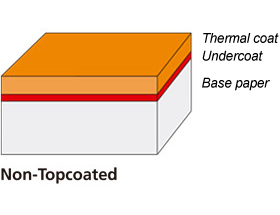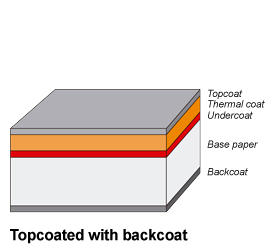Base paper
The base paper is a wood-free paper specially developed and produced by KANZAN to meet the specific requirements of thermal papers. It is thus oriented from the very start to the qualitative characteristics of the end product. Here, only the highest quality raw materials and additives are used.
Undercoat
All KANZAN thermal papers have an undercoat applied to the base paper. This guarantees an even and smooth surface onto which the thermal coat is applied. The undercoat enables high-resolution printing, supports a high image quality, prevents heat conduction into the paper and thus optimises the sensitivity characteristics of the thermal coat.

Topcoat
An additional topcoat can be applied on top of the thermal coat. Thermal paper with a topcoat makes sense if the surface is exposed to particular external influences like:
- mechanical abrasion (e.g. through scratches)
- chemical influences (e.g. through oils, fats, varnishes or organic solvents)
- environmental influences (e.g. through high humidity or water)
Moreover, a topcoat on the front side of the thermal paper extends the service life of the thermal head of the printer.

Backcoat
A backcoat is essential when the reverse side of the thermal paper is exposed, for example, to the following influences:
- migrating adhesives (e.g. adhesives which are used in the production of self-adhesive labels)
- plasticizers (e.g. from plastics like PVC).
Furthermore, special backcoats improve the stampability and the flatness of the thermal paper under different climatic conditions.